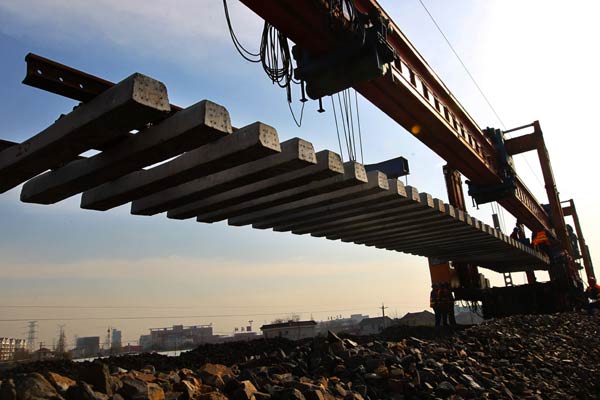 |
|
Rail tracks are laid on a route in Nantong, Jiangsu province. [Photo provided to China Daily] |
Urban railway transit, modern logistics and emerging industries to be new focus areas
Major development projects launched by the government have attracted investment to the tune of 3.1 trillion yuan ($500 billion) till May, indicating that the investment pipeline is still robust, a top government official said.
China launched seven project packages in December, including transportation, clean energy, oil and gas pipelines, health and mining. About 220 projects that are part of these packages have started construction by the end of May, Li Pumin, spokesman for the National Development and Reform Commission, said during a news conference on Tuesday.
Li said the NDRC is planning four new packages to inject new momentum into the sluggish economy, including urban rail transit, modern logistics, emerging industries and competitive manufacturing.
"Infrastructure investment continues to be a major driver for investment growth," he said.
Infrastructure investment rose 18.1 percent year-on-year during the first five months. However, growth in China's fixed-asset investment fell to a 15-year low during the same period. Since May, the pace of projects that resumed construction has accelerated, said Li.
Zhang Hanya, president of the Investment Association of China, told China Daily the economy has responded to a host of policy measures taken by the government and shown signs of recovery since May.
Capital inflows into the real estate sector are expected to see further momentum thanks to the central bank's recent cuts in reserve requirement ratios and key interest rates, he said.
"Too many macroeconomic measures have been put in place and a dramatic stimulus is not necessary in the short term," said Zhang.
Investment in urban rail transit this year is expected to exceed last year's 285.7 billion yuan. Till date, 39 cities have met the stipulated criteria for building subways and the number is expected to increase to around 50 by 2020.
Li Guoyong, an NDRC official, said: "With the acceleration in urbanization process, urban transit systems will be a natural solution for easing traffic congestion, not only in first-tier cities but also in second-and third-tier cities."
The urbanization rate is expected to exceed 60 percent by 2020 and the number of cities with a population of more than 1 million will exceed 200 during that period.
The threshold for building an urban transit system includes conditions that a city has an urban population in excess of 3 million and a GDP of more than 100 billion yuan.
About 60 new jobs are created per kilometer of a new subway during the construction and operation stages. By the end of this year, China's total subway network will reach 3,500 km. The total distance will reach 6,000 km by 2020 and generate several hundred thousand new jobs, Li from NDRC said.
About 22 cities have opened city transit systems with a total operational distance of 2,754 km. Both Beijing's and Shanghai's city transit systems have already exceeded 500 km.
The cost of building a subway has increased to 700 million yuan or 800 million yuan per km from 500 million yuan a few years ago, he said. The average cost has exceeded 1 billion yuan per km in Beijing.
Fundraising is not an issue for big cities such as Beijing and Shanghai. But many second-and third-tier cities are under fiscal pressure due to the sluggish property market and slower economic growth.
The NDRC has urged local governments to raise funds for the projects by issuing bonds and through social investment by way of public-private partnerships.
The top planner released a proposed public-private partnership list with more than 1,000 proposed infrastructure PPP projects in May with an expected total investment of 1.97 trillion yuan.
